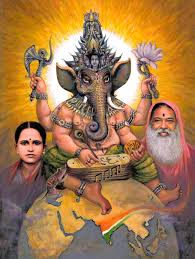Devotees should practise sadhana cathustaya (the four-fold spiritual practice). They are:
-
Nityānitya vastu vivekam (ability to discern objects that are transient from those that are eternal)
-
Ihamuthra phala bhoga vairagya (detachment from the fruits of action, both in this world and the next).
-
Samadamādi shatkasampatti (The 6 steps for controlling the mind and the senses).
-
Mumukshatvam: Intense burning desire for liberation.
These 4 collectively are known as sadhana cathushtaya.
Nityānitya vivekam: This is the ability to discern transient objects from those that are eternal. An in-depth scrutiny into the subject, will make the person realize that Brahma is the only permanent thing. He is eternal. He is indestructible. This entire world that we perceive around us has emerged from Him. As such, it is subject to destruction. It is temporary. Obtaining such in-depth understanding is first of the 4 steps of sadhana.
Ihamuthra phala bhoga vairagya: Seeking to experience worldly comforts is called Iha. Seeking heavenly comforts is Amutra. None of these desires is permanent. If one gets a stay in heaven due to the virtue of the meritorious deeds done here on earth, that stay is only as long as the merit exist. After that, the entity is thrown down. Hence even heavenly comforts are impermanent. With this understanding, one develops a detachment towards the luxuries of this world and the next. Developing such detachment is the second step.
Śamadamādi śatkasampatti: These are the 6 steps for controlling the mind and the senses.
a) Śama- Control of the mind i.e. controlling the inner sense organs.
b) Dama- Control of the external sense organs
c) Uparathi: Sacrificing the results that come from any action. Not expecting any result or reward for any action. It is a withdrawal from desire.
d) Titheeksha: Being equal-minded both in happiness and sorrows. It is also forbearance.
e) Shraddha: A firm belief and dedication towards Guru seva, towards the Vedas and towards the advice given by Guru (Guru vakyam).
f) Samādhāna: Developing patience and thorough understanding, living calmly.
These have been called sampada (wealth, prosperity). Acquiring these 6 forms of wealth is the 3rd step in the path.
Mumukshatvam: Getting rid of the ego (feelings of I-ness and mine-ness), developing a steady focus on attaining liberation and possessing a burning desire to achieve it is itself mumukshatvam.
We mentioned that Śama and dama means control of the inner and the outer sense organs. What does it imply?
There are 5 external organs of action (5 karmendriyas) and five organs of perception (5 jnanendriyas) totalling 10. When the four-fold mind is added, it constitutes 14 parts.
The 5 organs of action (karmendriyas): a) mouth; b) hand c) feet d) organs of reproduction e) organ of excretion.
The 5 organs of perception (Jnanendriyas): a) Ear b) skin c) eyes d) nose e) tongue.
Constituents of the mind are:
a) Manas- It eternally makes resolutions (sankalpas). It is the processing part of the mind.
b) Buddhi (intellect) - Discriminates between good and bad. It is the judge which discriminates and decides.
c) Chitta – Impressions of all our actions are stored here and they are are sent out as thought waves. It is the memory bank.
d) Ahankara (ego) – feelings of I-ness and mine-ness.
Controlling these 14 parts and preventing them from committing bad deeds is itself sadhana. How can the mind be brought to a state wherein it is devoid of all thoughts or modifications? To this, the Shastras state as follows:
A human being irrespective of whether he is a celibate, householder, vaanaprasta or a sanyasi (a renunciate), should through practice develop a selfless intellect. Under every circumstance or situation, he should try to get out of the worldly taapatrayas (afflictions) and bondages. With this the mind will be rendered without any thoughts.
- Bhaktimala 1986
